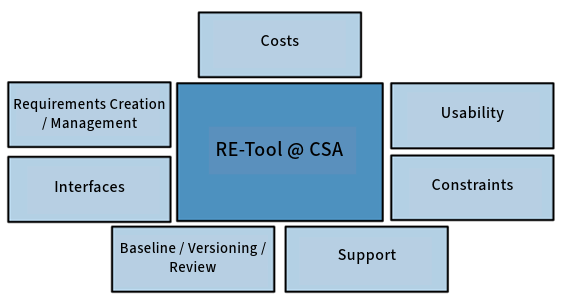The Right Tools in Requirements Engineering: What Really Matters
As mentioned in the blog post "From idea to finished product: requirements engineering sets the direction" requirements are a critical part of any project.
To capture and manage them as simply and efficiently as possible, there is a wide range of tools available. However, these tools vary in many aspects, such as functionality and costs, including licenses or maintenance.
Depending on the project’s requirements, the necessary features can differ significantly. For example, in a project with the highest safety level (SIL4), beyond the requirements themselves, additional information on the safety relevance and traceability of the requirements is also necessary.
Key Features of Requirements Engineering Tools
To select a suitable tool for the intended product development or product portfolio, several factors need to be considered.
The most important characteristics from our perspective are highlighted in the following figure and briefly described below.

Figure 1: Key points for selecting an RE tool
- Requirements Creation/Management: The tool must be able to create and manage requirements.
- Interfaces: The tool should be capable of communicating with other applications/tools through defined interfaces.
- Baseline/Versioning/Review: It is essential that baselines can be set to best support the review process and configuration management. The tool must be able to assign a unique ID to each requirement.
- Costs: A crucial factor includes the costs for licenses, expansions, training, etc.
- Usability: The tool should be as simple, intuitive, and efficient as possible, including multi-user support.
- Support: The availability and quality of user support and documentation should also be considered.
- Constraints: Considerations like server location or industry certification of the tool must not be overlooked.
The terms mentioned above are just general categories that require further specification. Additionally, tests should ideally be linked directly to the requirements and managed within the same tool. This helps avoid media breaks and enhances traceability between requirements and tests.
Once a requirements catalog is in place, it can be evaluated, expanded, and prioritized for all potential tools based on your preferences. A utility analysis is useful for this, allowing you to weigh different criteria and evaluate them independently. For instance, cost or a specific interface might be given high priority.
With the results of this analysis, you'll have a solid foundation for discussing and selecting the ideal tool.
Given our experience working with various clients, we are well-versed in many tools like Polarion, Doors NG, and others.
We’d be happy to assist you in the selection process.
Contact us for expert RE tool consultation >

Daniel Niggli
BSc BFH in Microtechnology
Test manager, test engineer
About the author
Daniel Niggli has been working at CSA Engineering AG for almost 3 years.
In recent years, he has worked in various roles as a project manager, verifier and requirements engineer on a range of functional safety projects.
Among other things, he has revised an existing functional specification for an automated warning system.
